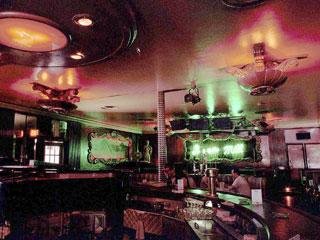Chicago and the Volstead Act: Green Mill
By Chuck Sudo in Food on Dec 4, 2008 4:00PM
 Back in the day we closed down Green Mill (4802 N. Broadway, 773-878-5552) more times than we care to remember. Few things are as perfectly matched as 3 a.m. creeping on sunrise, a perfect martini in front of you, someone from out of town looking for an "authentic Chicago experience" and the Sabertooth Hammond organ combo providing a fitting soundtrack to a night that ends with salty diner coffee, runny eggs and the Sunday Sun-Times. It almost makes one long for the smoking ban to be lifted for only a few hours. Almost.
Back in the day we closed down Green Mill (4802 N. Broadway, 773-878-5552) more times than we care to remember. Few things are as perfectly matched as 3 a.m. creeping on sunrise, a perfect martini in front of you, someone from out of town looking for an "authentic Chicago experience" and the Sabertooth Hammond organ combo providing a fitting soundtrack to a night that ends with salty diner coffee, runny eggs and the Sunday Sun-Times. It almost makes one long for the smoking ban to be lifted for only a few hours. Almost.
Between Sean Parnell's writeup of Green Mill at his Chicago Bar Project website and a smaller piece some hack wrote for Time Out Chicago over the summer, the history of Green Mill has been covered ad nauseum. But we'll do it again, 'cause it's fun (and because I found my notes from when I interviewed owner Dave Jemilo for the TOC piece). Green Mill started out in 1907 as an everyday tavern called Pop Morse's Roadhouse. The establishment was particularly popular with people looking for a bit of an Irish wake before heading to St. Boniface Cemetery on Clark Street. Businessman Tom Chamales — who later built the Riviera Theater — bought the place three years later and decided to turn the bar into our local version of the Moulin Rouge. Chamales built a sunken outdoor garden and dance floor, a rumba room upstairs, and erected a green windmill atop the building. Hence the bar's name.
When Prohibition went into effect, Chamales and his brothers made a decided deal with the devil. They offered a management contract (actually a 25 percent stake in the club) to a gentleman by the name of Danny Cohen and his partners, among them a wholesome gent named Jack "Machine Gun" McGurn. McGurn, of course, was Serena/Blair BFF tight with one Alphonse Capone and long believed to be one of the masterminds behind the St. Valentine's Day Massacre. McGurn and Cohen kept the booze flowing with the help of a "gentleman's agreement" with our city's finest (cops on the take? In Chicago? Who'd a thunk?), serving up blended whiskey, gin and other tonics in coffee cups for "medicinal purposes."
Folks heading to Green Mill in the Roaring 20's were greeted by the dulcet tones of a singer named Joe E. Lewis. That is, until Lewis accepted an offer for more money with a downtown club for his services. Then McGurn had some associates pay Lewis a visit, slit his throat and cut out part of his tongue. It ended Lewis' singing career, but he made lemonade from lemons and refashioned himself as a comedian.
Almost as many people came to Green Mill for a chance sighting of Capone. If Scarface did make an appearance, customers knew because the band would play his favorite song: Gershwin's "Rhapsody in Blue." then Capone would take his place in the booth by the end of the bar, where he and his men could keep a close eye on both entrances for any signs of trouble. Today, portraits of Capone and McGurn hang on Green Mill's back bar as a homage to the era. The piano and riser behind the bar is also a reminder going back to Green Mill's past.